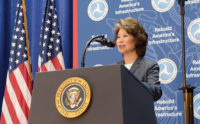A massive effort to revamp the American air-traffic-control system from land-based to satellite-based equipment, dubbed NextGen, could result in greater flight efficiency and fuel cost savings at all major hubs by 2014, says Randolph Babbitt, Federal Aviation Administration chief. He also stressed the need for the next generation of land-side and air-side infrastructure.
Babbitt urged members of the American Association of Airport Executives last month in Dallas to work toward implementing multimodalism. “We have to advance our infrastructure to NextGen standards,” he said. “It’s the only way to keep pace with the rest of the world.”
He recounted riding a magnetically levitated high-speed train between downtown Shanghai and the airport, traveling 20 miles in eight minutes. “It’s not a pipe dream,” he said. “We need to seriously think about how we access our airports.”
He also noted South Korea’s Incheon airport, where returning citizens need only seconds to be processed through customs, thanks to high-tech tools.
Currently eight of 27 installations of NextGen are under way, he said. The FAA has awarded $4.4 billion in contracts, out of a total of $7 billion. The new system allows pilots to know other planes’ locations more precisely, regardless of weather. The system also will reduce the interval needed between each takeoff or landing.
Many in the aviation world seek legislation that will allow passenger facility charges to rise to at least $7, from $4.50. The move would bolster federal funding for airports. In Dallas, airport officials shared experiences on managing construction programs with limited budgets.
For example, instead of spending $11.8 million on a 400-ft runway extension, New York’s Elmira-Corning airport opted for a $9,000 installation of crushable concrete blocks to act as a barrier against a plane skidding off the runway, said airport manager Ann Crook.
At the Palm Springs, Calif., airport, a decade-old, $3-million decision replace grass with crushed granite on the airfield has resulted in minimal maintenance costs and no wildlife issues, said executive director Thomas Nolan.
Long Beach Airport has managed to remain financially stable despite aviation’s overall declining revenues thanks to planning scalable projects that address short-term, urgent needs, said director Mario Rodriguez.
div id="articleExtras"


Post a comment to this article
Report Abusive Comment